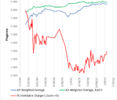Xelloss99
Member
This is probably because the adapter is rated for 300A. While Model 3 and Y with North America and Korea firmware that support the CCS adapter cap the limit to 300A, the 2021 refresh Model S (and presumably X) do not and can and will exceed this limit, charging in excess of 500A, exceeding the adapter rating.The strangest part about the CCS1 adapter is that Tesla does not recommend using with chargers >300A due to insufficient testing.
Electrify America, the largest public charging network in the US, exclusively uses 350A and 500A chargers.
Setec CCS to Tesla Adapter
Welp, get excited for Tesla’s adapter. I’m on a 2000 mile route that is almost all v2 superchargers, and the old 120kw supercharger in this town was also full, but meanwhile I’m just over here doing 200+kw at an empty EA station. Xoxo.
Setec CCS to Tesla Adapter
Welp, get excited for Tesla’s adapter. I’m on a 2000 mile route that is almost all v2 superchargers, and the old 120kw supercharger in this town was also full, but meanwhile I’m just over here doing 200+kw at an empty EA station. Xoxo.
This is in the Setec thread with user @rhuber who hacked a Setec adapter to be passrhrough which basically turned it into a passive Tesla CCS adapter .
Setec CCS to Tesla Adapter
DISCLAIMER: DO NOT DO THIS DO NOT DO THIS DO NOT DO THIS After discussions with @JWardell and @Ingineer, we were able to confirm that the tesla ccs adapter is entirely passthrough and just acts as a physical adapter, with no internal circuitry. The reason this works is because the newer cars...
Tesla hasn't sold 2021 refresh S/X outside of North America yet so the Korea market doesn't have them and the 3/Y there won't exceed 300A due to firmware cap, but the warning may be a "cover your ass" for anyone using an import with the adapter.



